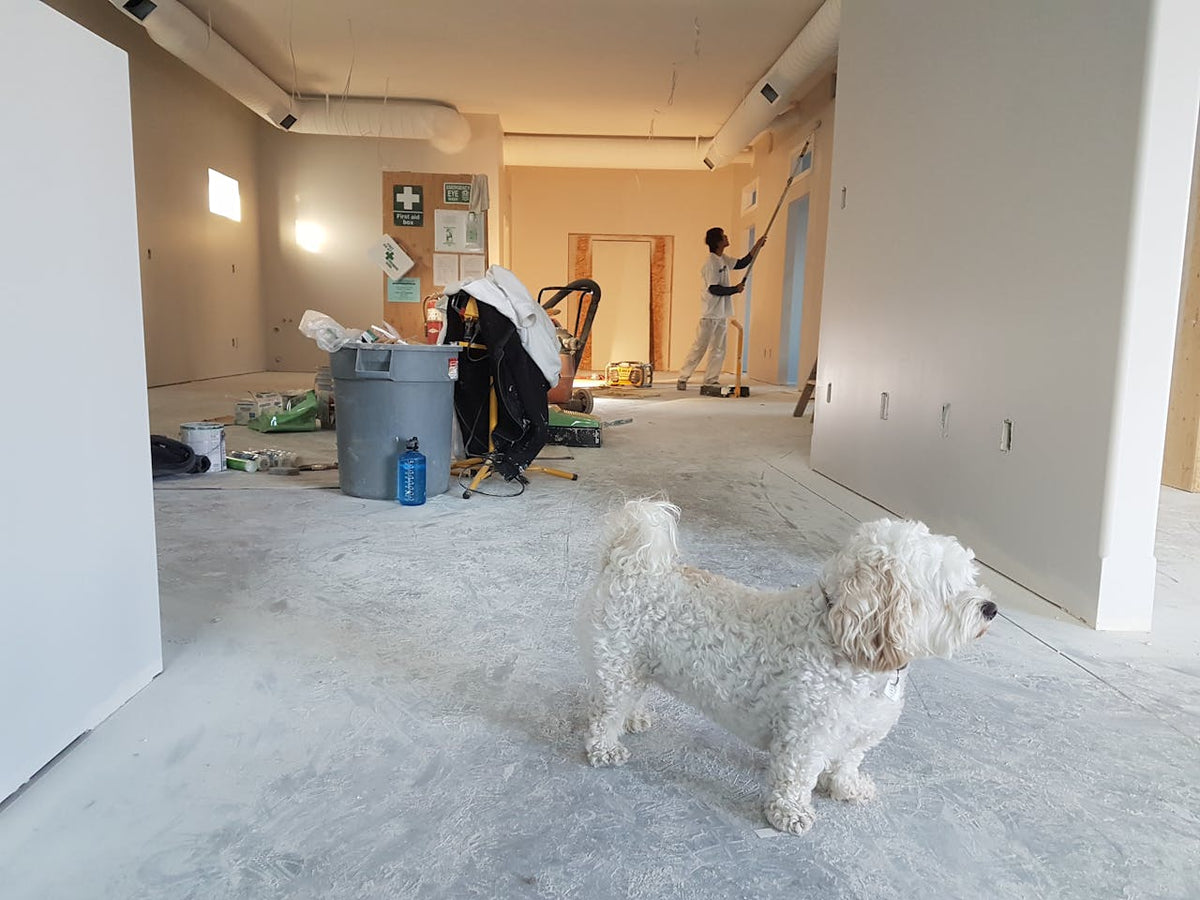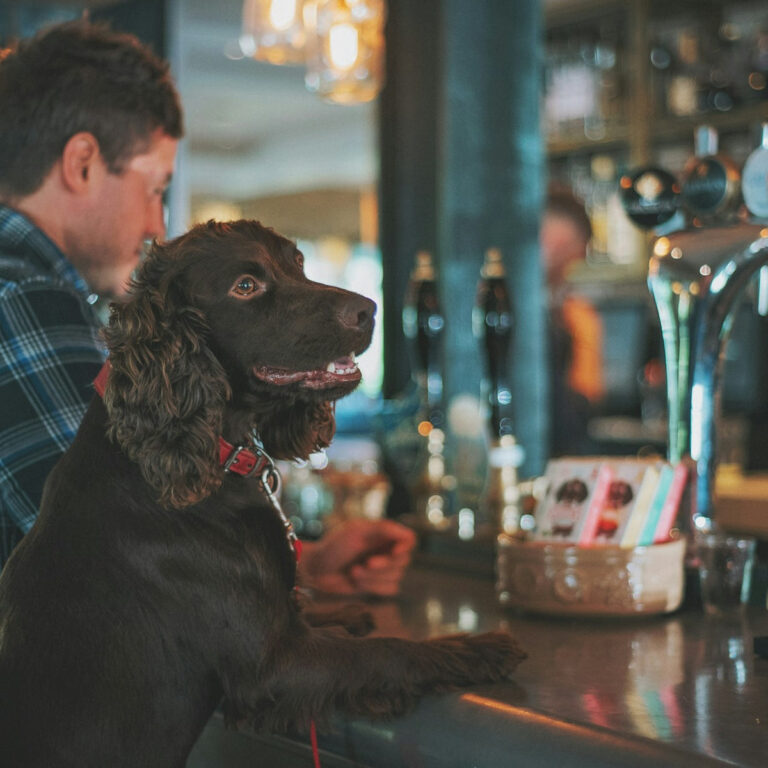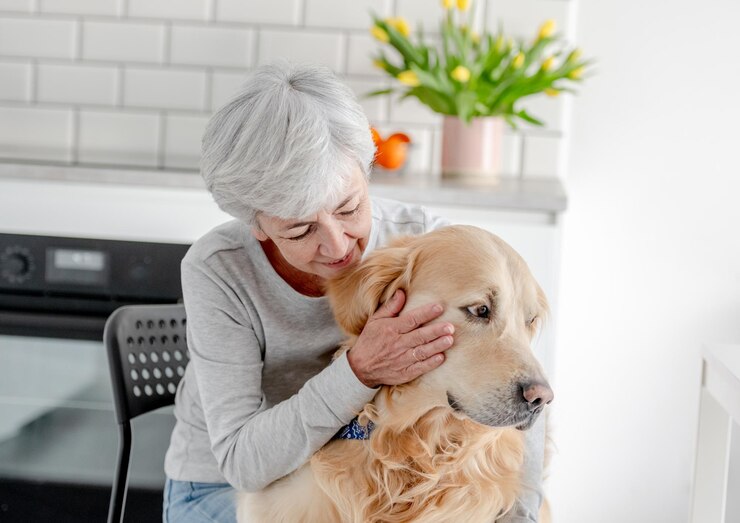Renovating your home is a major undertaking consisting of multiple moving parts and lots of strangers in and out of your house. Your furry friend doesn’t understand the concept of home remodeling so the process can be terrifying and stressful for them. Keeping your pets comfortable during renovations is a priority.
Tips to Keep Your Pet Safe During Home Renovations
It’s great that you’re finally getting around to that kitchen remodel you’ve dreamed about for years. However, before you start swinging hammers and ripping out cabinets, make sure you have steps in place to keep your pets safe.
1. Update ID Tags and Microchips
Check your pet’s tag and chip information to make sure everything is current. If your dog or cat isn’t chipped, this is a great time to talk to your vet about microchipping your pet. In the unlucky circumstance that your pet escapes through an open door or gate, you have peace of mind knowing they have identification.
ID tags are important, but in the event your pet loses their collar, a microchip provides a backup. According to data from the Human Animal Support Services (HASS), families are three times more likely to be reunited with pets with microchips.
2. Create a Safe Zone for Your Pet
Carve out an area that won’t be touched during renovations to serve as your pet’s safe zone. Try to settle on a place as far removed from the construction as possible. It could be your bedroom, bathroom, home office, or any other space that workers won’t need to enter.
Place your pet’s bed, toys, food and water dishes, and other necessities in the room. Depending on your pet’s personality, keep the door closed while workers are present, or use a safety gate in the open doorway.
If your pet gets nervous about the activity, it’s best to shut the door and play some white noise or soothing music to help mask the sounds. You can still use the safety gate as an extra precaution in case someone unknowingly opens the door.
3. Have a Conversation With Your Contractor
Talk with your contractor and any other workers handling your home renovations to alert them to your pet’s presence. Review precautions you have in place, like a certain room being off-limits, keeping the gate shut at all times, etc.
However, don’t rely on this discussion to make everything okay. Even the most professional people are human, and that means, they can make mistakes. It’s always in your pet’s best interest to keep them secure during renovations instead of relying on your contractor to watch out for them.
4. Keep Dangerous Products Out-Of-Reach
Remodeling your home usually comes with plenty of dangerous supplies, like various chemicals and sharp tools. These items need to be locked up or out of reach at all times when your pet is around.
If you have cats that love high places, then simply placing these items up on a shelf won’t do. Either put them under lock and key or devise a way to completely block the area from your pets.
5. Consider Boarding Your Pet or Going on a Vacation
One of the best ways to keep your pet safe during renovations is to look into pet boarding or see if your fur friend can stay with a neighbor or family member. This might not be practical if you’re dealing with renovations that last several weeks. It all depends on your budget or your friend’s willingness to take your pet for a long time.
Get recommendations from friends, family, your vet, and your groomer. You can also check out petsitter.com or similar sites to find recommended sitters in your area.
If the remodeling project is only for a weekend or a week, you may be able to sync up a vacation with your pet. The bonus is you get out of the chaos, too. You can always ask a friend to check in on things for you when you’re away.
6. Walk Through the Construction Zones Every Day
Before you let your pet roam, walk through the construction areas each day (and your entire house). Look for stray nails, screws, tools, or products that might have been left behind.
Secure the area, but only let your pet near these sites if you have absolutely no choice. For example, you have to walk your pet through the demolished kitchen to get to your backyard, etc.

How Do You Keep Your Pet Calm During Construction?
Keeping your pet physically safe during home renovations is vital, but it’s also essential to take care of them emotionally and mentally. Use these tips to reduce your furry friend’s stress levels and keep them comfortable during remodeling.
1. Maintain Your Pet’s Schedule as Much as Possible
Pets thrive on routine and get stressed out when things go awry. Stick to your pal’s usual schedule as much as possible throughout the renovations so their world doesn’t flip upside-down entirely.
2. Keep Their Safe Space as Familiar as You Can
In addition to maintaining your pet’s schedule, keep their surroundings as familiar as possible. A recognizable safe environment helps calm anxious pets.
Even though certain parts of the house are barred, mimic your pet’s favorite hangout in their temporary safe space. If they’re able to remain in their usual safe zone, all the better. Fill it with familiar toys, a T-shirt with your scent, and other comforting items.
Your pet should also have a space where they feel they can get away if they feel threatened. (A place where your pet can go and not feel as if someone can follow them.) It might be as deluxe as a DIY catio or as simple as a cozy, covered pet crate.
3. Give Your Pet Plenty of Exercise
Give your pet ample opportunities to exercise. It could be going on walks, play sessions, or running around the backyard with you.
The more exercise your pet gets, the less likely they are to get amped up about the renovations. The activity gives them a chance to burn up energy so they spend more time snoozing and relaxing when it’s time to go back to their safe space.
4. Use Interactive Toys to Distract Your Pet
Giving your pet something to do is a great way to distract them and keep them mentally stimulated. Interactive treat puzzles or toys like the Rolly Cannoli provide a chance for pets to shift their focus. They turn their attention away from the hectic buzz of activity happening in the house onto something more enjoyable.
5. Try Different Calming Products
Calming sprays, collars, and diffusers can help ease your pet’s nerves. Encouraging your pet to lick also has a calming effect since it releases endorphins. Spread some peanut butter on a licking mat to give your pal a tasty distraction and get the endorphins flowing.
6. Play Music or Other Ambient Noise
Pets have superior hearing to humans, so if the noise in your house is driving you bonkers, it’s worse for your pets. Playing white noise or the radio masks the sounds that may rile up your dog or cat. Also, it’s believed that music affects pets, with soft, slower tempos typically having a calming effect.
7. Check on Your Pet Throughout the Day
If you can’t be home with your pet during construction hours, check on them throughout the day. Go home on your lunch break if you work nearby, walk your pup, and snuggle your cat.
If you can’t make it home, see if a neighbor can check in on your pet a couple of times during the day or hire a sitter or dog walker. A product like the Furbo pet camera enables you to keep tabs on your pet while you’re away and even lets you dispense yummy treats remotely.
8. Talk With Your Vet
If your pet is continuing to struggle after all your efforts to keep them calm, talk to your vet. Your dog or cat may need a little extra assistance. Your vet can offer specific treatments or may suggest you give medication to your pet to help them relax.
9. Stay Calm During Renovations
Remember, your pets can sense your stress, so it’s important for you to stay calm during the remodeling process. Yes, the painter spilled a gallon of peachy pink paint on your new floors, but blowing your top won’t do you or your pet any good.
Make Your Pets a Priority When Remodeling Your Home
Getting the home upgrades you want is fabulous, but you won’t enjoy that brand-new space if your pet gets hurt or lost in the process. Use these tips to keep your furry family members safe and sound during remodeling. For more helpful tips on all things dog and cat, check out the rest of the Neater Pets blog.




